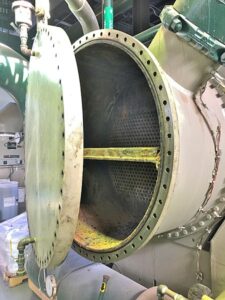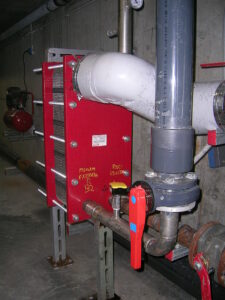The concept of “Heat exchanger efficiency” with heat exchanger efficiency related several facts will be summarize. Depending on the performance of the ideal system heat exchanger efficiency will be determined.
The term of Heat exchanger efficiency can be explain as the relationship between the amount of heat which is transfer in the physical heat exchanger to the amount of heat which is transfer in the ideal heat exchanger. With the help of heat exchanger efficiency we can analysis and design of the heat exchanger.
What is heat exchanger efficiency?
The process of heat exchanger is happened between two fluids which are containing different temperature and the fluids can be classified by any solid wall or the fluids can be touched position to each other.
The term of heat exchanger efficiency explain as, the proportion between the quantity of heat transfer through heat exchanger that is the actual one which one works as a input of the system and the quantity of heat transfer through heat exchanger that is the practical one which one works as a out of the system.
The term heat exchanger efficiency can be written as,
η = Qact/Qideal
Where,
η = Heat exchanger efficiency
Qact = The amount of heat which is transfer in the physical heat exchanger
Qideal = The amount of heat which is transfer in the ideal heat exchanger
Heat exchanger efficiency formula:
The formula of the heat exchanger efficiency is given below,
Q̇ = UA ΔT
Where,
Q̇= The amount of heat flow through the heat exchangers and its unit is Watt
U = Heat transfer coefficient and its unit is Watt per meter square degree centigrade
A = The area from where heat is floe and its unit is square meter
ΔT= Temperature difference and its unit is Kelvin.

Image Credit – Wikipedia
How to calculate heat exchanger efficiency?
For the system of heat exchanger the efficiency can be calculating by comparing the factors of actual performance with practical performance.
Heat exchanger efficiency = Actual output / Output of the practical system ….eqn (1)
But where the practical heat exchanger is not available for that case eqn (1) is not applicable. In that case we can use the product of heat transfer coefficient and the surface area from where the heat is flowing which is express as UA to express the best rate of the heat transfer that can be easily can get by the given process condition ΔT. So, the equation we are used in that case is given below,
Q = UA(FΔTLM) ….eqn (2)
Where,
Q = The amount of heat flow through the heat exchangers and its unit is Watt
U = Heat transfer coefficient and its unit is Watt per meter square degree centigrade
A = The area from where heat is floe and its unit is square meter
FΔTLM = Log mean temperature difference and its unit is Kelvin
The LMTD approach is applied when input and output temperature is given but the size of the heat exchanger is not selected. The alternative approach for the LMTD the thermal effectiveness method is applied which is calculating the practical world heat transfer amount and the inside of a heat exchanger heat transfer amount. The expression is given below,
E = Q/Qmax ...eqn (3)
Typical heat exchanger efficiency:
The term typical heat exchanger efficiency explain as, the relationship between the amount of heat which is transfer in the physical heat exchanger to the amount of heat which is transfer in the ideal heat exchanger is gives the flow rate near about 90 percentage.
Typical heat exchanger efficiency value is more than the shell and tube, spiral, kettle and tubular heat exchanger.
How to improve heat exchanger efficiency?
Improving the efficiency of heat exchanger is given below,
Online cleaning:-
Online cleaning helps to prevent the scaling and fouling without interrupting the operation of the heat exchanger or without stopping the operation of the heat exchanger. Online cleaning including the basket, brush and ball type system. Online cleaning treat a chemical conjunction arrangement and standalone approach.
Offline:-
The offline cleaning another name is pigging. Offline cleaning is very useful to improve the efficiency of heat exchanger. In this process a equipment which is use looks like a bullet which is placed in every tube of the heat exchanger and pushed down with air high pressure. Chemical cleaning, hydro lancing and hydro blasting are common methods to use offline cleaning.
Periodic cleaning:-
The most useful methods to clean the dirt and debris from the heat exchanger are periodic cleaning. After a certain time lots of unwanted dirt will gather into the system which decreases the working efficiency thus after a time periodic cleaning is very essential.
Maintaining heat exchanger:-
To boost the efficiency of the heat exchanger regular maintenance is very important. The maintaining of heat exchanger helps to prevent blockage, leakage and fouling of the system.
Cleaning of the PHE manually:-
Manual cleaning is important to follow the instruction of the manufacturer’s. When PHE is installed when prefer to clean the plates of the system without isolate them from the frame of the system.
How to calculate plate heat exchanger efficiency?
For the system of heat exchanger the efficiency can be calculating by comparing the factors of actual performance with practical performance.
Heat exchanger efficiency = Actual output / Output of the practical system ….eqn (1)
But where the practical heat exchanger is not available for that case eqn (1) is not applicable. In that case we can use the product of heat transfer coefficient and the surface area from where the heat is flowing which is express as UA to express the best rate of the heat transfer that can be easily can get by the given process condition ΔT. So, the equation we are used in that case is given below,
Q = UA(FΔTLM) ….eqn (2)
Where,
Q = The amount of heat flow through the heat exchangers and its unit is Watt
U = Heat transfer coefficient and its unit is Watt per meter square degree centigrade
A = The area from where heat is floe and its unit is square meter
FΔTLM = Log mean temperature difference and its unit is Kelvin
The LMTD approach is applied when input and output temperature is given but the size of the heat exchanger is not selected. The alternative approach for the LMTD the thermal effectiveness method is applied which is calculating the practical world heat transfer amount and the inside of a heat exchanger heat transfer amount. The expression is given below,
E = Q/Qmax …eqn (3)
How to improve efficiency of plate heat exchanger?
The way the improve efficiency of plate heat exchanger is listed below,
Reduce the thickness of the plate:-
The design of the plate thickness is not depend on the corrosion resistance. The plate design thickness is depending on the pressure bearing capacity. The plate thickness the heat exchanger can be increases by the pressure bearing capacity.
Plate should be choosing:-
Choosing the plate for the heat exchanger plays a very role. The materials which have thermal conductivity such as copper alloy, stainless steel, titanium steel are selected. The thermal conductivity for the stainless steel is about 14.4 watt per meter Kelvin.
Decreasing the thermal resistance:-
The thermal resistance is of heat exchanger of fouling layer is reduce just because of to avoid scaling from the plate. The fouling thickness is when about 1 mm that time the amount of heat transfer coefficient is reduces about 10 percentages. For this reason it is important to control the quantity of water on the both portions of the heat exchanger.

Image Credit – Wikipedia
How to calculate shell and tube heat exchanger efficiency?
For the system of heat exchanger the efficiency can be calculating by comparing the factors of actual performance with practical performance.
Heat exchanger efficiency = Actual output / Output of the practical system ….eqn (1)
But where the practical heat exchanger is not available for that case eqn (1) is not applicable.
So, the equation we are used in that case is given below,
Q = UA(FΔTLM) ….eqn (2)
Where,
Q = The amount of heat flow through the heat exchangers and its unit is Watt
U = Heat transfer coefficient and its unit is Watt per meter square degree centigrade
A = The area from where heat is floe and its unit is square meter
FΔTLM = Log mean temperature difference and its unit is Kelvin
The LMTD approach is applied when input and output temperature is given but the size of the heat exchanger is not selected. The alternative approach for the LMTD the thermal effectiveness method is applied which is calculating the practical world heat transfer amount and the inside of a heat exchanger heat transfer amount. The expression is given below,
E = Q/Qmax …eqn (3)
How to increase efficiency of shell and tube heat exchanger?
The process of the increases efficiency of shell and tube heat exchanger is listed below,
- Online cleaning
- Offline
- Periodic cleaning
- Reduce the thickness of the plate
- Plate should be choose
- Decreasing the thermal resistance
- Maintaining heat exchanger
- Cleaning of the PHE manually
Heat exchanger efficiency vs. effectiveness:
The major difference between heat exchanger efficiency and effectiveness is discuss below,
| Parameter | Heat exchanger efficiency | Heat exchanger effectiveness |
| Definition | Heat exchanger efficiency is the quality or state of being suitable in performance. | Heat exchanger effectiveness is a degree which defines the success story of something which creates desired result. |
| Focus | Heat exchanger efficiency focuses on the resources and process. | Heat exchanger effectiveness focuses on Goal of the result. |
| Thinking | Heat exchanger efficiency is only applied for present state. | Heat exchanger effectiveness applied in long term. |
| Belief’s | To do things correct in process. | To do correct things in process. |
Heat exchanger efficiency vs. flow rate:
The major difference between heat exchanger efficiency and flow rate is discuss below,
| Parameter | Heat exchanger efficiency | Flow rate |
| Definition | The relationship between the amount of heat which is transfer in the physical heat exchanger to the amount of heat which is transfer in the ideal heat exchanger | A fluid is flow in a particular time volume of per rate time. |
| Formula | Q̇= UAΔT | Q = vA |
Advantages of Fireplace heat exchanger efficiency:
Advantages of Fireplace heat exchanger efficiency is listed below,
- Smoke is not produced
- Efficient energy
- Economical
- Maintenance is low
- Long lifespan
- Availability
Water to water heat exchanger efficiency:
Water to water heat exchanger efficiency can be explain as, the type of heat exchanger device which carry liquid cooling and which is appropriate process for reduce heat from many classifications of industrial methods.
Air to air heat exchanger efficiency:
In the unit of air to air heat exchanger air runs for long time is greater the device of heat exchanger. The amount of recovery heat is about 80 percentages. The units of air to air heat exchanger are long, rectangular and shallow.
What affects heat exchanger efficiency?
The effect of the heat exchanger efficiency is with the increasing of capacity ratio for the counter flow heat exchanger is also an increase and with the increasing of capacity ratio for the flow heat exchanger is also a decrease.
What is the maximum efficiency for parallel flow heat exchanger?
No matter how large the exchanger is or how high be the flow of overflow at transfer coefficient, the maximum efficiency for parallel flow heat exchanger is 5%.
Hi..I am Indrani Banerjee. I completed my bachelor’s degree in mechanical engineering. I am an enthusiastic person and I am a person who is positive about every aspect of life. I like to read Books and listen to music.